Page 24 of 340
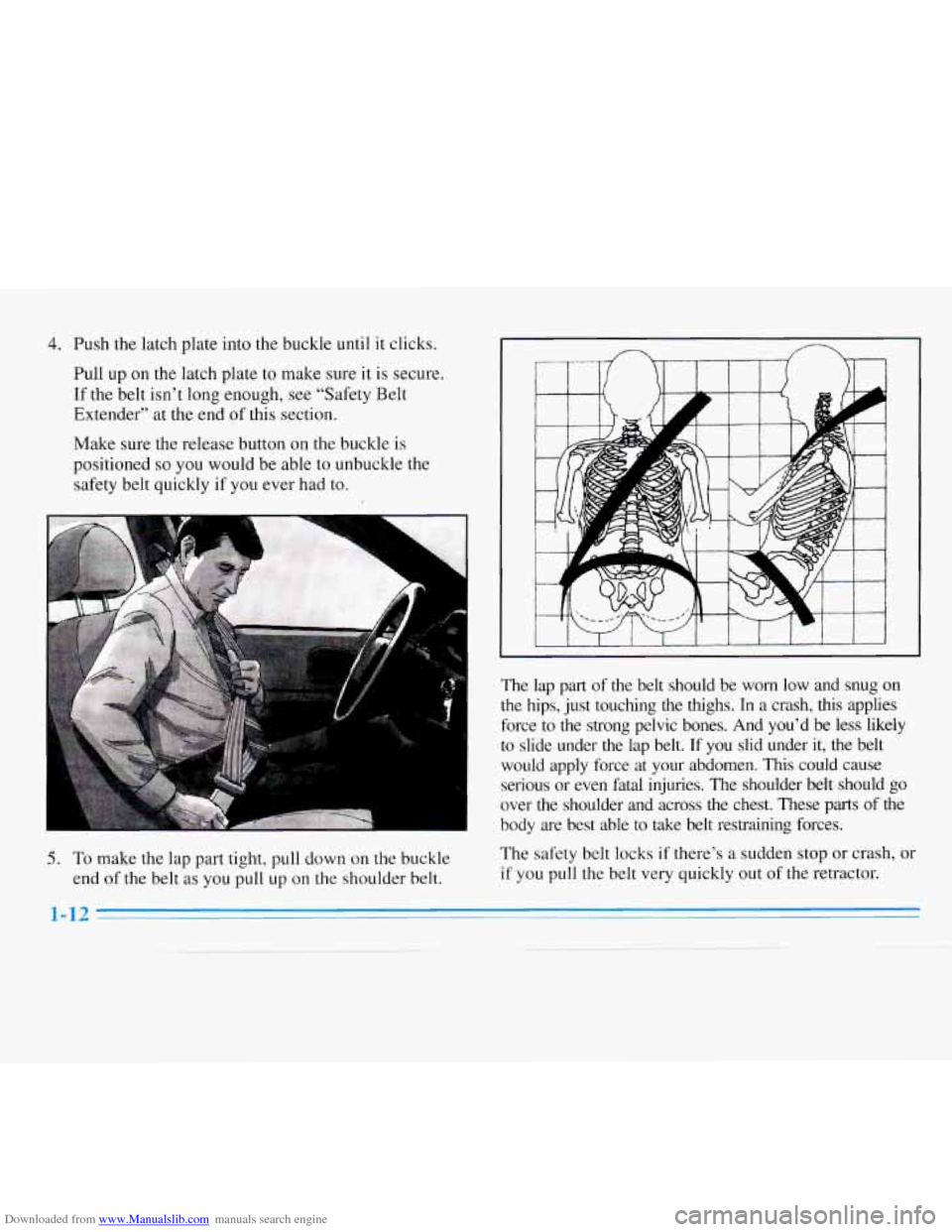
Downloaded from www.Manualslib.com manuals search engine 4. Push the latch plate into the buckle until it clicks.
Pull
up on the latch plate to make sure it is secure.
If the belt isn’t long enough, see “Safety Belt
Extender” at the end of this section.
Make sure the release button on the buckle is
positioned
so you would be able to unbuckle the
safety belt quickly if you ever had to.
5. To make the lap part tight, pull down on the buckle
end
of the belt as you pull up on the shoulder belt. The
lap part of the belt should be worn low and snug on
the hips, just touching
the thighs. In a crash, this applies
force to the strong pelvic bones. And you’d be
less likely
to slide under the lap belt. If you slid under it, the belt
would apply force at your abdomen. This could cause
serious or even fatal injuries. The shoulder belt should go
over
the shoulder and across the chest. These parts of the
body are best able
to take belt restraining forces.
The safety belt locks
if there’s a sudden stop or crash, or
if you pull the belt very quickly out of the retractor.
Page 30 of 340
Downloaded from www.Manualslib.com manuals search engine A C” I:
Air bags inflate with great force, faster than the
blink
of an eye. If you’re too close to an inflating
air bag, it could seriously injure you. Safety belts
help keep you in position for an air bag inflation
in
a crash. Always wear your safety belt, even
with an air bag. The driver should sit as far back
as possible while still maintaining control of
the vehicle.
An inflating air bag can seriously injure small
children. Always secure children properly in your
vehicle.
To read how, see the part of this manual
called “Children” and the caution label on the
right front passenger’s safety belt.
AIR BAG
There is an air bag readiness
light
on the instrument
panel, which shows
AIR BAG or the
air bag symbol.
~~~~~~~ ~ ~ ~ ~
The system checks the air bag’s electrical system for
malfunctions. The light tells you
if there is an electrical
problem. See “Air Bag Readiness Light’’ in the Index
for more information.
Page 37 of 340
Downloaded from www.Manualslib.com manuals search engine I
Rear Seat Passengers
It’s very important for rear seat passengers to buckle up!
Accident statistics show that unbelted people in the rear seat are hurt more often in crashes than those who
are
wearing safety belts.
Rear passengers who aren’t safety belted can be thrown
out of the vehicle in a crash. And they can strike others
in the vehicle who
are wearing safety belts.
Rear Seat Outside Passenger Positions
U 1.
Lap-Shoulder Belt
The positions next to the windows have lap-shoulder
belts. Here’s how to wear one properly.
2.
Pick up the latch plate and pull the belt across you.
Don’t let
it get twisted.
The shoulder belt may lock if you pull the belt across
you very quickly.
If this happens, let the belt go back
slightly to unlock it. Then pull the belt across you
more slowly.
Push the latch plate into the buckle until it clicks. Pull
up on the latch plate to make sure it is secure.
1-25
I
Page 43 of 340
Downloaded from www.Manualslib.com manuals search engine heavy you can’t hold it. For example, in a crash
at only
25 mph (40 km/h), a 12-lb. (5.5 kg) baby
will suddenly become a 240-lb.
(110 kg) force on
your arms. The baby would be almost impossible
to hold.
Secure the baby
in an infant restraint.
Never hold a baby in your arms while riding in a
vehicle.
A baby doesn’t weigh much -- until a
crash. During a crash a baby will become so
CAUTION: (Continued)
Page 44 of 340
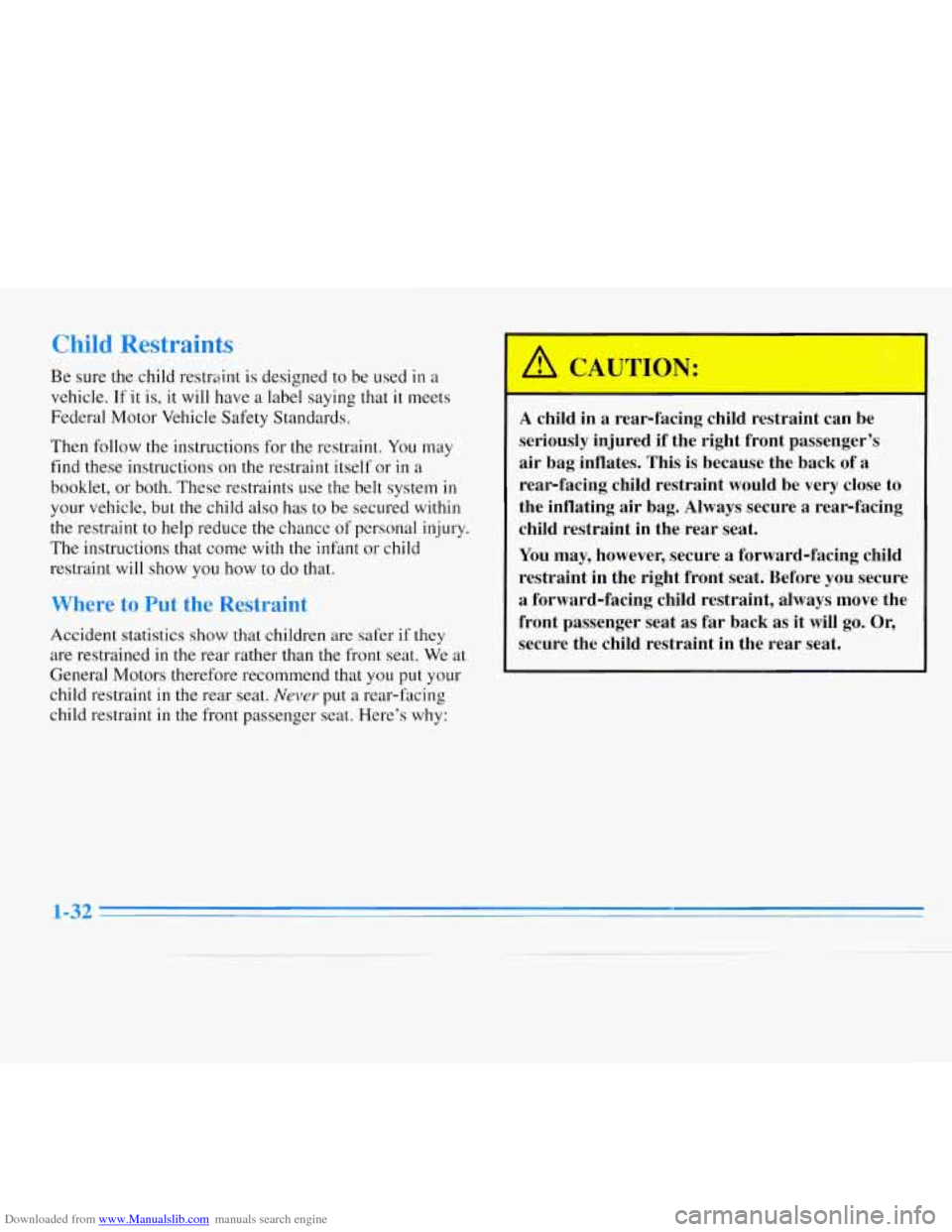
Downloaded from www.Manualslib.com manuals search engine A YL
Be sure the child restraint is designed to be used in a
vehicle.
If it is, it will have a label saying that it meets
Federal Motor Vehicle Safety Standards.
Then follow the instructions for
the restraint. You may
find these instructions on the restraint itself or
in a
booklet, or both. These restraints use the belt system
in
your vehicle, but the child also has to be secured within
the restraint to help reduce the chance of personal injury.
The instructions that come
with the infant or child
restraint will show you how to do that.
Accident statistics show
that children are safer if they
are restrained in
the rear rather than the front seat. We at
General Motors therefore recommend that you put your
child restraint
in the rear seat. Never put a rear-facing
child restraint
in the front passenger seat. Here’s why:
r
A child in a rear-facing child restraint can be
seriously injured if the right front passenger’s
air bag inflates. This is because the back of a
rear-facing child restraint would be very close to
the inflating air bag. Always secure a rear-facing
child restraint
in the rear seat.
You may, however, secure a forward-facing child
restraint in the right front seat. Before you secure
a forward-facing child restraint, always move the
front passenger seat as far back as it will go. Or,
secure the child restraint in the
rear seat.
Page 45 of 340
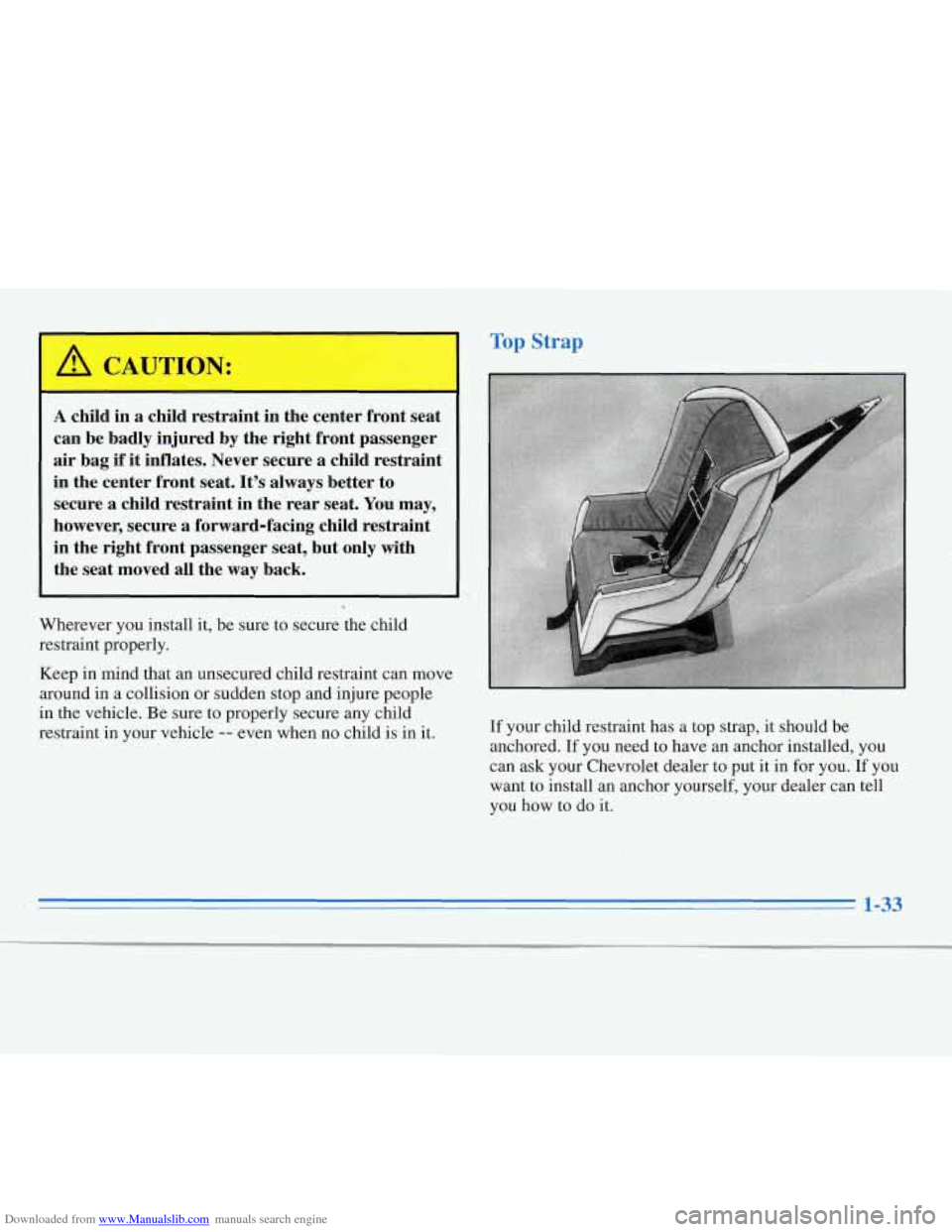
Downloaded from www.Manualslib.com manuals search engine I
A child m a child restraint in the center front seat
can be badly injured by the right front passenger
air bag
if it inflates. Never secure a child restraint
in the center front seat. It’s always better to
secure a child restraint in the rear seat.
You may,
however, secure a forward-facing child restraint
m the right front passenger seat, but only with
the seat moved
all the way back.
Wherever you install it, be sure to secure the child
restraint properly.
Keep in mind that
an unsecured child restraint can move
around in a collision or sudden stop and injure people
in
the vehicle. Be sure to properly secure any child
restraint in your vehicle
-- even when no child is in it. If
your child restraint has a top strap,.it should be
anchored.
If you need to have an anchor installed, you
can ask your Chevrolet dealer to put it in for you.
If you
want to install an anchor yourself, your dealer can tell
you how to
do it.
.l-f
Page 46 of 340
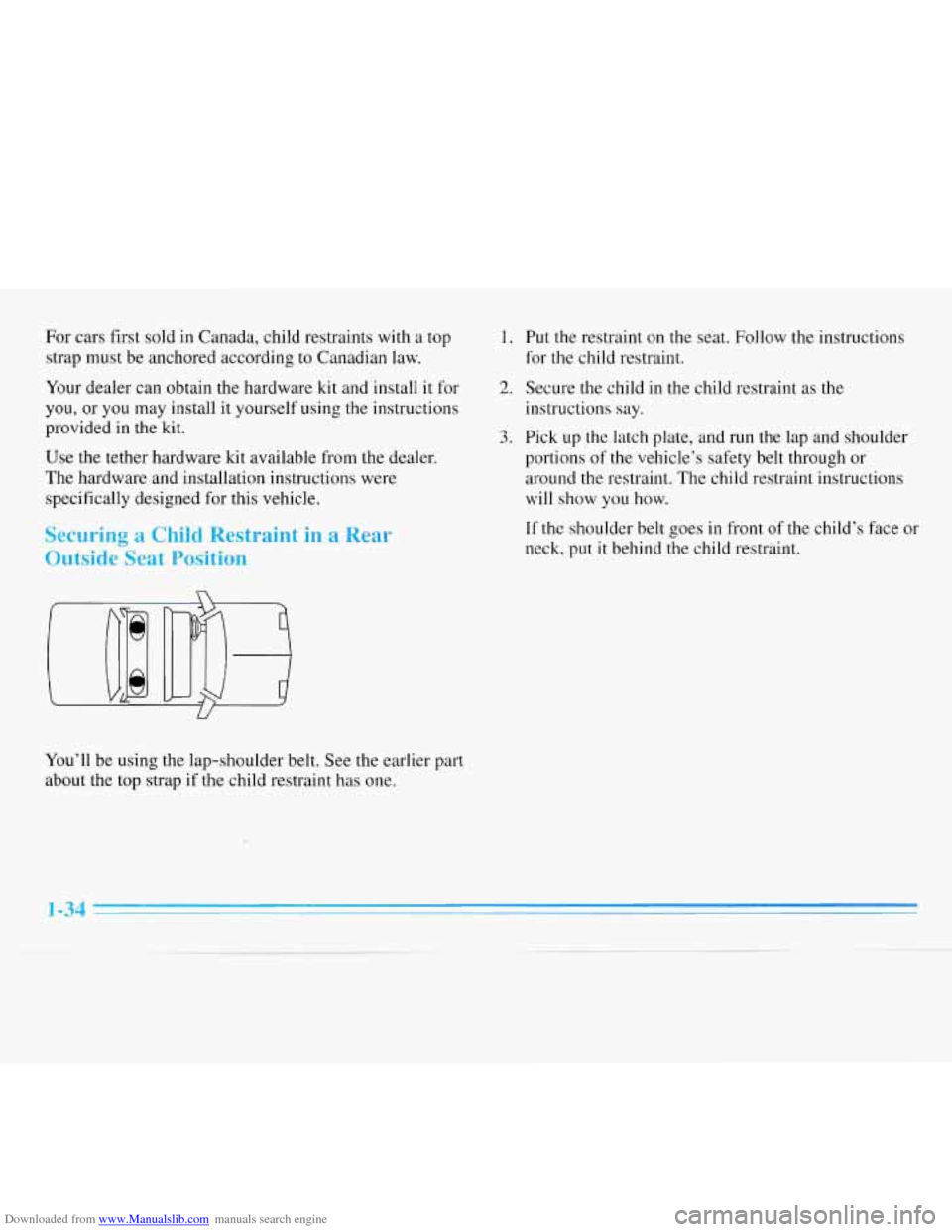
Downloaded from www.Manualslib.com manuals search engine For cars first sold in Canada, child restraints with a top
strap must be anchored according to Canadian law.
Your dealer can obtain the hardware kit and install it for
you, or you may install it yourself using the instructions
provided in the
kt.
Use the tether hardware kit available from the dealer.
The hardware and installation instructions were
specifically designed for this vehicle.
Securing a Child Restraint in a Rear
Outside Seat Position
U
You’ll be using the lap-shoulder belt. See the earlier part
about the top strap if the child restraint has one.
1. Put the restraint on the seat. Follow the instructions
for the child restraint.
2. Secure the child in the child restraint as the
instructions
say.
3. Pick up the latch plate, and run the lap and shoulder
portions of the vehicle’s safety belt through or
around the restraint. The child restraint instructions
will show you how.
If the shoulder belt goes in front of the child’s face or
neck,
put it behind the child restraint.
1-34
Page 48 of 340
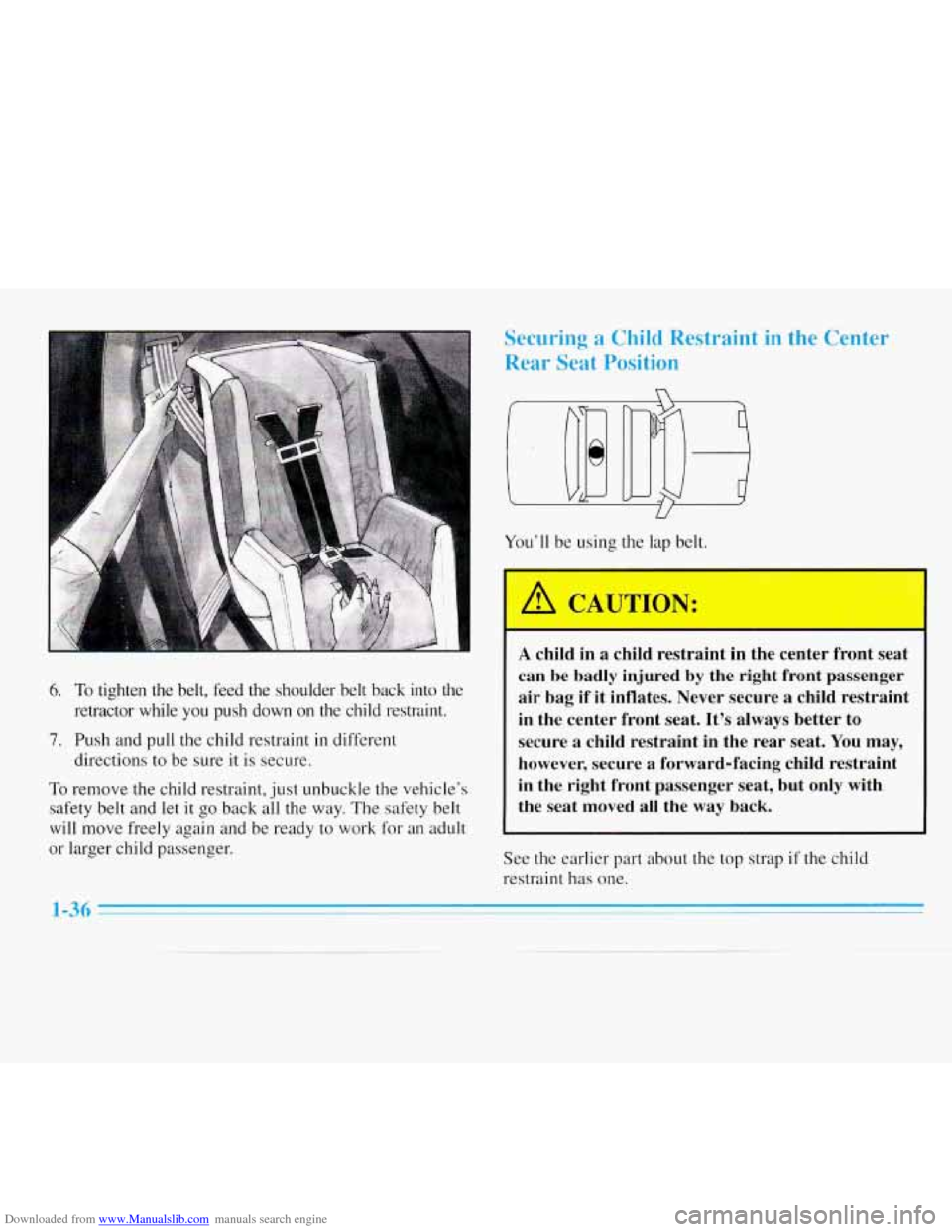
Downloaded from www.Manualslib.com manuals search engine 6. To tighten the belt, feed the shoulder belt back into the
retractor while you push down on the child restraint.
7. Push and pull the child restraint in different
directions to
be sure it is secure.
To remove the child restraint, just unbuckle the vehicle’s
safety belt and let it
go back all the way. The safety belt
will move freely again and
be ready to work for an adult
or larger child passenger.
1-36
Securing a Child Restraint in the Center
Rear Seat Position
n
You’ll be using the lap belt.
A child in a child restraint in the center front seat
can be badly injured by the right front passenger
air bag
if it inflates. Never secure a child restraint
in the center front seat. It’s always better to
secure a child restraint in the rear seat. You
may,
however, secure a forward-facing child restraint
in the right front passenger seat, but only with
the seat moved all the way back.
See the earlier part about the top strap if the child
restraint has one.